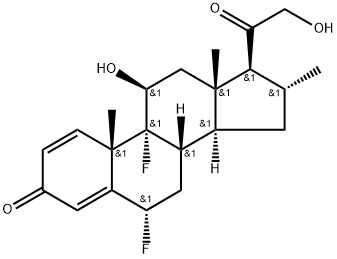Manufacturing Process
16α-Methyl-6α,9α-difluoro-δ4-pregnene-11α,21-diol-3,20-dione-21-acetate
(MP = 229°/232°-234°C (with decomposition) is dehydrogenated in 1.2-
position by means of Bacillus lentus, Mutant MB 284, whereby the 21-acetate
group is simultaneously saponified. (It is possible under the same conditions
to start with the free 21-hydroxyl compound.)
For this purpose a fermenter made of stainless steel having a 50 liter capacity
is charged with 30 liters of a nutrient solution of 0.1% yeast extract, 0.5%
cornsteep and 0.2% glucose, heated for one-half hour at 120°C for
sterilization purposes, and after cooling, inoculated with a bacterial suspension
of Bacillus lentus MB 284.
After 24 hours of growth at 28°C under stirring (220 revolutions per minute)
and aeration (1.65 m3/hr), 1.8 liters of the obtained culture is removed under
sterile conditions and transferred with 28 liters of the same sterilized nutrient
medium into a fermenter of the same size.
Simultaneously, 6 g of 16α-methyl-6α,9α-difluoro-δ4-pregnene-11β,21-diol3,20-dione-21-acetate in 200 cc of dimethylformamide are added and the
fermentation is continued for 50 hours under the same conditions.
The course of the fermentation is tested by removal of samples which are
extracted with methyl isobutyl ketone. The extracts are analyzed by thin layer
chromatography using a system of benzene/ethyl acetate (4:1).
After further working up there is obtained an oily crystalline residue which is
subjected to chromatography on silica gel. The 16α-methyl-6α,9α-difluoroδ1,4-pregnadien-11β,21-diol-3,20-dione is eluated with ethyl acetatechloroform (1:2), it is recrystallized from ethyl acetate/ether and then formed
to melt at 240°/242°-244°C. The yield is 60% of the theoretical. The product
is reacted with valeric acid chloride to give the valerate ester.
